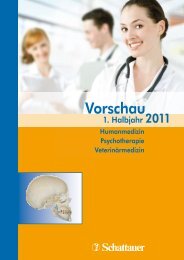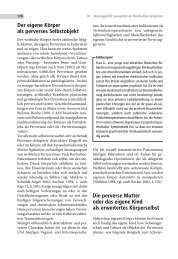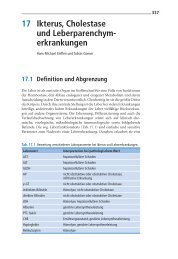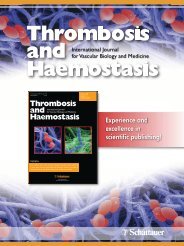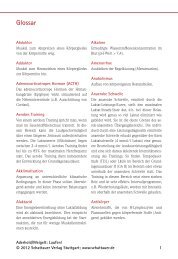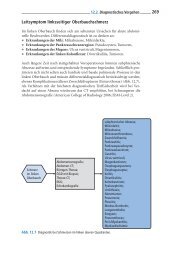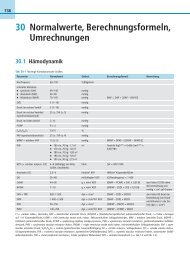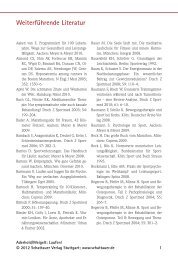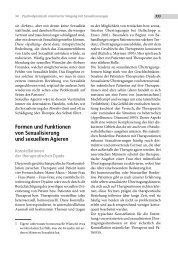DVO Guideline 2009 for Prevention, Diagnosis and Therapy of ...
DVO Guideline 2009 for Prevention, Diagnosis and Therapy of ...
DVO Guideline 2009 for Prevention, Diagnosis and Therapy of ...
You also want an ePaper? Increase the reach of your titles
YUMPU automatically turns print PDFs into web optimized ePapers that Google loves.
60 <strong>DVO</strong> <strong>Guideline</strong> Osteoporosis <strong>2009</strong><br />
increased fracture risk after termination <strong>of</strong><br />
treatment with glitazones or a change to<br />
another antidiabetic medication is to be expected<br />
but is not explicitly established (D).<br />
7.25 Drugs which may lead to Falls<br />
Sedatives (relative risk approx. 1.5 times)<br />
(B), drugs which provoke orthostatic reactions<br />
(D), neuroleptics (D) <strong>and</strong> antidepressants<br />
(relative risk 1.2 to 1.5 times <strong>for</strong> hip<br />
fractures) (B) are associated with an increased<br />
fracture risk <strong>for</strong> both genders<br />
(E47, E48). Interactions with other risks<br />
<strong>and</strong> therapeutic relevance have not been<br />
sufficiently examined, there<strong>for</strong>e, no independent<br />
fracture risk was assumed in the<br />
subsequent multi-factorial 10-year fracture<br />
risk assessment (chapter 8 <strong>and</strong> section<br />
10.5). The increased fracture risk<br />
might be reversible after termination <strong>of</strong> the<br />
drug intake (D).<br />
7.26 Proton Pump Inhibitors<br />
The intake <strong>of</strong> proton pump inhibitors has<br />
also been associated with fractures (E110).<br />
In line with present trials the risk only exists<br />
<strong>for</strong> an intake over several years. The mechanism<br />
is still not clear as well as whether the<br />
moderate to high risk in univariate analysis<br />
is independent <strong>of</strong> other risk factors. An inclusion<br />
as an independent risk factor which<br />
might influence the recommendations<br />
with regard to diagnostics <strong>and</strong> therapy is<br />
not currently justified. A continuous treatment,<br />
however, should be critically considered<br />
<strong>for</strong> persons at risk.<br />
7.27 Remarks on Risk Factors<br />
Knowledge <strong>of</strong> the risk factors indicated<br />
above is important:<br />
1. <strong>for</strong> the identification <strong>of</strong> avoidable fracture<br />
risks,<br />
2. <strong>for</strong> the prognostic evaluation <strong>of</strong> the total<br />
fracture risk depending on the number<br />
<strong>and</strong> severity <strong>of</strong> the individual risks<br />
which cannot be avoided.<br />
Whether <strong>and</strong> to what extent fracture risks<br />
that are independent <strong>of</strong> bone density,<br />
gender, age, <strong>and</strong> fracture level that contribute<br />
to the absolute fracture risk can be<br />
influenced by antiosteoporotic medi-<br />
cation has not yet been sufficiently examined<br />
<strong>for</strong> many <strong>of</strong> these risk factors. Evidence<br />
with regard to strength <strong>and</strong> independence<br />
<strong>of</strong> the above mentioned risk factors is<br />
more uncertain <strong>for</strong> older men than <strong>for</strong><br />
post-menopausal women. For many risk<br />
factors different risk gradients are described<br />
<strong>for</strong> osteoporotic fractures collectively,<br />
vertebral fractures <strong>and</strong> hip fractures.<br />
The relative risks given above are there<strong>for</strong>e<br />
only to be regarded as approximate. Only<br />
<strong>for</strong> some <strong>of</strong> the risk factors mentioned<br />
above, such as gender, age, fracture level<br />
<strong>and</strong> weight, have the interactions between<br />
each other <strong>and</strong> with bone density been sufficiently<br />
well examined (E26–E29, E78).<br />
Interactions <strong>of</strong> some <strong>of</strong> the other risk factors<br />
described above have in the meantime<br />
also been modelled more explicitly in an<br />
online calculation algorithm <strong>for</strong> the assessment<br />
<strong>of</strong> fracture risk supported by the<br />
WHO (FRAX ® risk analysis, www.shef.ac.<br />
uk/FRAX) (E78).<br />
The FRAX ® risk analysis, however, only<br />
includes some <strong>of</strong> the risk factors <strong>and</strong> is<br />
more limited in fracture prognosis compared<br />
to other fracture prognosis models,<br />
this analysis including morphometric vertebral<br />
fractures <strong>and</strong> falls (B) (E79–E82).<br />
An osteoporosis which is dominantly<br />
<strong>and</strong> causally associated with certain diseases<br />
or conditions is termed secondary osteoporosis,<br />
whereas discrimination between<br />
a risk factor <strong>and</strong> a secondary osteoporosis<br />
is more blurred. In the case <strong>of</strong> rare<br />
diseases which might be associated with a<br />
secondary osteoporosis <strong>and</strong> a high fracture<br />
risk, it is recommended <strong>for</strong> the assessment<br />
<strong>of</strong> the total fracture risk to include the<br />
known or assumed independent relative<br />
fracture risk <strong>of</strong> these diseases into the context<br />
<strong>of</strong> the fracture prediction analyses described<br />
in chapters 8 <strong>and</strong> 10.<br />
7.28 Remarks on FRAX ®<br />
During the process <strong>of</strong> updating the <strong>DVO</strong><br />
guideline, a German, Austrian <strong>and</strong> Swiss<br />
version <strong>of</strong> FRAX ® was published. FRAX ® is<br />
a calculation tool developed by a WHO<br />
working group assessing country specific<br />
10-year probability <strong>of</strong> fracture risk <strong>of</strong> hip<br />
fractures <strong>and</strong> so-called “major fractures”<br />
(hip fractures, clinical vertebral fractures,<br />
humeral fractures <strong>and</strong> <strong>for</strong>earm fractures)<br />
based on clinical risk factors <strong>and</strong> DXA bone<br />
density <strong>of</strong> the femoral neck. The FRAX ® calculations<br />
<strong>for</strong> Germany, Austria <strong>and</strong> Switzerl<strong>and</strong><br />
use country-specific incidences <strong>of</strong> hip<br />
fractures <strong>and</strong> mortality data, <strong>and</strong> <strong>for</strong> all<br />
countries data from 12 prospective epidemiologic<br />
studies carried out worldwide<br />
on the relationship <strong>of</strong> hip fractures with<br />
other fractures <strong>and</strong> the interactions <strong>of</strong> different<br />
clinical risk factors.<br />
The evaluation <strong>of</strong> the 10-year fracture risk<br />
using FRAX ® is very similar to the 10-year<br />
fracture risk assessment using the �table 3 in<br />
section 10.3 with regard to the underlying risk<br />
factors. The <strong>DVO</strong> working group decided,<br />
however, to give preference to the �tables 3<br />
<strong>and</strong> 4 in section 10.3 <strong>for</strong> the current guideline<br />
instead <strong>of</strong> using FRAX ® . This decision was<br />
taken because the working group came to the<br />
conclusion that the country-specific FRAX ®<br />
models which have only recently been published<br />
are still in development <strong>and</strong> could still<br />
change. On the other h<strong>and</strong>, the �table 3 in<br />
section 10.3 has been used since 2003 in those<br />
countries where the <strong>DVO</strong> guideline is published,<br />
thus, implementation <strong>of</strong> an absolute<br />
10-year fracture risk has already taken place<br />
<strong>and</strong> changing to FRAX ® would not <strong>of</strong>fer<br />
those advantages compared to many other<br />
countries in which only now a change from a<br />
relative to an absolute fracture risk by using<br />
FRAX ® is taking place. Furthermore, there are<br />
some issues described below in detail <strong>for</strong><br />
which the <strong>DVO</strong> working group is <strong>of</strong> the<br />
opinion that the risk may be described more<br />
accurately by the <strong>DVO</strong> risk assessment compared<br />
to the present FRAX ® model:<br />
1. One important difference between the<br />
<strong>DVO</strong> model <strong>and</strong> FRAX ® is the inclusion<br />
<strong>of</strong> morphometric vertebral fractures in<br />
the <strong>DVO</strong> model. Due to the lack <strong>of</strong> data<br />
<strong>for</strong> morphometric fractures in epidemiological<br />
studies, which are the basis <strong>for</strong><br />
FRAX ® , FRAX ® only includes clinical<br />
vertebral fractures <strong>and</strong> does not distinguish<br />
between different grades <strong>of</strong> severity<br />
<strong>of</strong> vertebral fractures nor between the<br />
subsequent risk in case <strong>of</strong> vertebral <strong>and</strong><br />
peripheral fractures. However, with<br />
morphometric fractures being an important<br />
factor <strong>for</strong> the prognosis <strong>of</strong> future<br />
fractures independent <strong>of</strong> other risk factors,<br />
the guideline working group regards<br />
the inclusion <strong>of</strong> morphometric<br />
fractures as important <strong>for</strong> risk assess-<br />
Osteologie 1/2011 © Schattauer 2011



